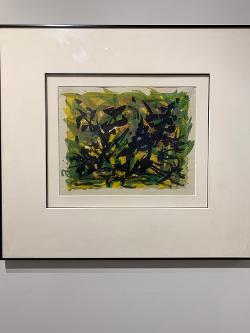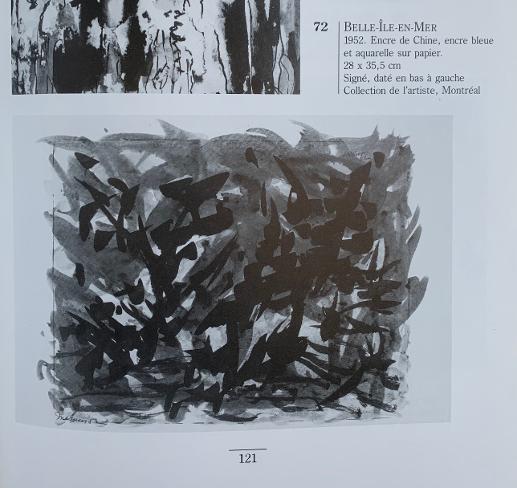Jean McEWEN
(1923-1999)
Vendu / Sold
Jean McEwen (1923-1999)
Encre de Chine, encre bleue et aquarelle sur papier
Titre: Belle-Ile-En-Mer
1952
signé en bas à gauche
Format: 10.25 x 13.25 ins ( 26 x 33.7 cms )
Provenance:
Galerie Simon Blais, Montreal
Private Collection, Canada
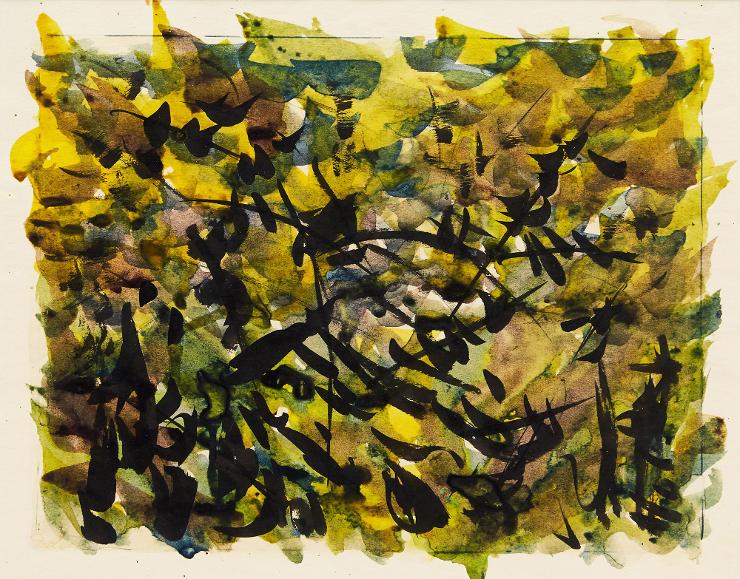
En 1952 Mc Ewen se trouve à Paris dans une conjoncture exceptionnelle, qui lui permet de découvrir à la fois l'oeuvre de Riopelle, de Sam Francis et de Jackson Pollock, ainsi que l'art des musées. Ceux de Paris, bien sûr, mais aussi ceux d'Espagne et d'Italie, qu'il visite au printemps, et ceux de Hollande, qu'il voit à l'automne. Durant l'été, il fait, en compagnie de Riopelle, un séjour à Belle-Ile-en-Mer, séjour qui s'avère décisif sur sa peinture.
Mc Ewen fait ses débuts à Paris en participant en décembre à un accrochage de groupe chez Nina Dausset avec Riopelle, Serpan et Sam Francis, parmi d'autres.
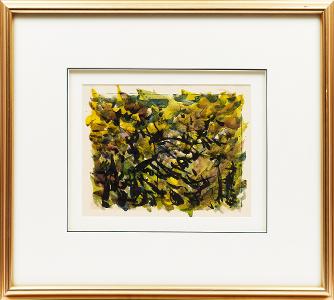
L'examen d'une série d'encres sur papier exécutées durant l'été en Bretagne à Belle-Ile-en-Mer, permet de constater que ces petits travaux ont joué un rôle moteur dans l'abandon de la référence au paysage, ou du moins aux motifs végétaux. À un réseau de taches d'encre de couleurs très vives se superpose un réseau de taches noires à l'encre de Chine qui n'a rien de linéaire, à la différence de celui qu'ont retrouve dans les aquarelles de Riopelle de la même période.
Dans le cas de Mc Ewen, il s'agit plutôt d'une articulation de deux réseaux mis en rythme l'un par l'autre. Et ce rythme est ici purement formel, le peintre ayant abandonné toute velléité de transcrire le mouvement des vagues.
Oeuvres comparés avec McEwen (Coll. du Musée)/ Riopelle en 1952
Jean Mc Ewen, La profondeur de la couleur, p. 24/25
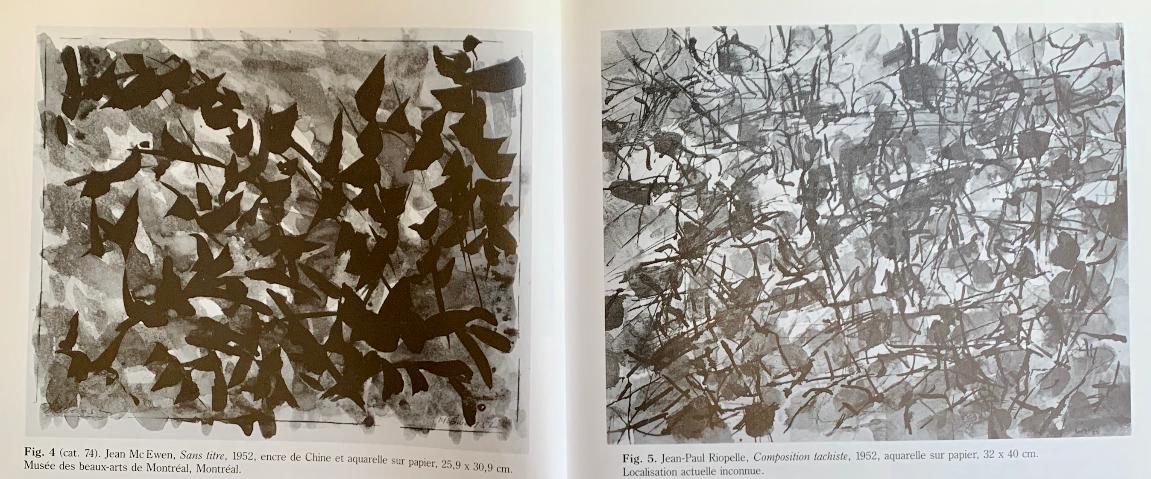
Montreal-born painter Jean McEwen is most well-known for his abstracted paintings that focus on light and color relationships. Born in 1923, McEwen trained as a pharmacist at the University of Montreal and wrote poetry for Québec based literary journals, such as Gants du ciel. McEwen’s initial art career was inspired by a film, The Moon and Sixpence, which is based off of the life and work of Paul Gauguin. As a self-taught artist he was most interested in the feelings that paintings gave him and the exploration of color and light. While his paintings are abstract in nature, some may find that their eyes piece together imagery, such as water damage or ice-covered windows when viewing his works. During his lifetime his paintings toured the United States, Japan, Brazil, and throughout Canada.
McEwen was mentored by Automatiste artist, Paul Émilie Borduas in the early 1950s. At Borduas’ suggestion, McEwen traveled to Paris for a year where he was mentored by Jean Paul Piopelle. Together they traveled to Spain, Italy, Holland, and spent the summer in Brittany, France. After spending this time in Europe, he began working in a style that incorporated ideas from the French Impressionists as well as Abstract Expressionists who were popular in the United States. McEwen worked in a style that favored symmetrical compositions, and subtly referenced bodily movement and its relationship to nature.
Throughout the early 1950s, McEwen began regularly appearing in galleries in Québec and Ontario. His first solo exhibition took place in Ottawa at Galerie Agnes Lefort, and he appeared in Montreal’s Galerie Actuelle for an exhibition on non-figurative art in the 1950s. In 1960, he published his first book, Midi Temps J’aime-Poème en Couleur. Based off of his time spent on the east coast, McEwen shared poetry and his drawings in color in his publication. Until 1961, McEwen was working full-time for a Montreal based pharmaceutical company. After receiving a grant from the Canada Council for the Arts, he reduced his hours spent at the pharmacy to focus on painting. He continued working at the pharmacy part-time until the 1970s.
After leaving the pharmaceutical industry, McEwen accepted lecturer positions at the Université du Québec à Trois Rivières and at Concordia University’s Department of Visual Arts. The Montreal Museum of Fine Arts dedicated the first retrospective to McEwen’s art in 1987. In 2019, the Montreal Museum of Fine Arts put on an exhibition, Untamed Colour: Celebrating Jean McEwen, to honour the artist and showcase the selection of the artist’s works that the museum has collected over the past two decades.
Literature Sources: The Canadian Encyclopedia, “Jean McEwen” Historica Canada, Accessed June 18, 2020
Ian McGillis, “Discovered Again: MMFA Honours Jean McEwen 20 Years After His Death, “Montreal Gazette, September 27, 2019
We extend our thanks to Danie Klein, York University graduate student in art history, for writing and contributing this englishartist biography.
Jean McEwen (1923-1999)
Encre de Chine, encre bleue et aquarelle sur papier
Titre: Belle-Ile-En-Mer
1952
Format: 28 x 35.5 cm
Provenance:
Collection de l'artiste (1988)
Galerie Waddington & Gorce (1992)
Collection particulière 1992-2020
Exposition:
Jean McEwen, La profondeur de la couleur, cat. 72
11 décembre 1987-24 janvier 1988
Musée des Beaux-Arts de Montréal
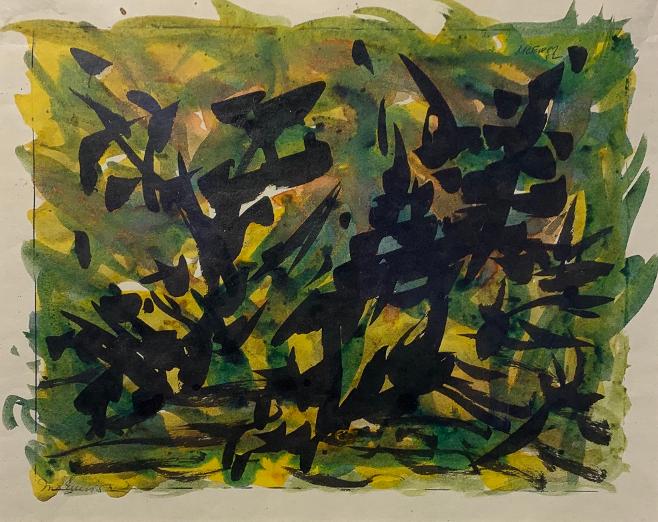
La présente oeuvreest ici cataloguée numero 72,
Jean Mc Ewen, La profondeur de la couleur, p. 121
